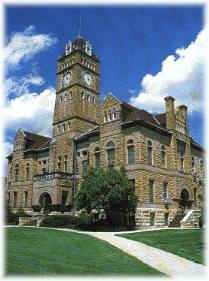
Waconda Springs for centuries inspired wonder among its visitors. Both Indians and whites marveled at Kansas' largest saltwater spring. The diameter at the base is 300 feet. Waconda is a deep-seated spring, the source of its supply being the saliferous shale immediately overlaying the Dakota sandstone which in this section is 600 to 800 feet below the surface. Samuel C. Pomeroy, on a tour of the Solomon River valley in 1870, called Waconda Springs "a most wonderful and marvelous sight".
"At first i declared it the Crater of an Ancient Volcano," Pomeroy wrote. The Water occupying its hollow center is fathomless, and about 200 feet in diameter in a perfect circle! It is always brimming full and running over on all sides... The hills about it were as sacred to the Indians as those about Jerusalem."
Many Plains Indians regarded springs as the dwelling place of supernatural powers. The Kansas name for Waconda Springs meant "spirit water". Indians of several tribes made pilgrimages to the spot, tossing beads, weapons, blankets, and other offerings to Waconda's waters.
The Pawnee recognized a dozen sacred places in Nebraska and Kansas. Nearly all were associated with water and known as "holy ground". Waconda Springs was thought to mark the location of an underwater lodge where animals of many species gathered and held council.
"Animals, while not gods, were a medium through which Pawnee individuals could acquire knowledge and power," explained historian Rita Napier. "The goal of Pawnee life was to increase one's power in order to live in complete accord with the laws of the universe."
Through a dream of vision, a fortunate Pawnee might visit the lodge beneath Waconda Springs. There the animals would teach them skills such as performing magic, hypnotism, or, most often, the healing of wounds and disease. Pawnee medicine societies traced their origins to such visits, and their ceremonies included smoke-offerings to Waconda Springs.
Kansas' early white settlers attributed medicinal properties to the state's many mineral springs. Senator Pomeroy seized on Waconda's commercial potential, predicting that a health resort of "towering magnificence" would arise. In 1884, developers fenced the spring and constructed a luxury hotel nearby.
The hotel became a sanitarium and spa in 1906. For over a half century patients came to "take the cure" at Waconda Springs. The mineral water was said to relieve a host of ailments from rheumatism to hemorrhoids, insomnia, and discolored skin.
A diver on the 4th of July, 1906, went down as far as possible, finding no bottom to the dark blue water which never froze in winter. Rain or drought never affected its calm and indifferent tranquillity. Many people today say the water rose and fell with the ocean tides.
But these virtues were overshadowed by the goal of controlling Kansas' water supply. In 1944, the Federal Bureau of Reclamation announced its plans to dam the Solomon River at Glen Elder -- and inundate Waconda Springs. In 1970, the waters of Waconda Lake closed over the famous spring.